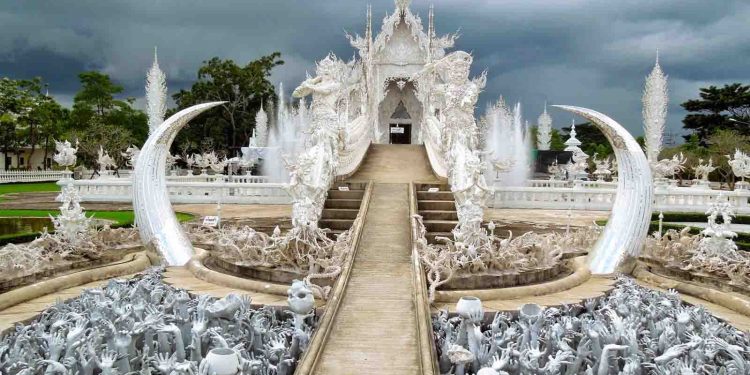Journeymarvel – Thailand, a land rich in cultural heritage and stunning architecture, is home to one of the most impressive and iconic temples in the world – Wat Rong Khun, or better known as the White Temple. Located in the province of Chiang Rai, this temple captivates visitors with its unique architectural beauty, as well as the mystery and profound meanings hidden behind each detail.
Location Map : Wat Rong Khun
What are the unique features of this temple?
What sets Wat Rong Khun apart from other temples in Thailand is its completely white color. The white color symbolizes purity and truth in the teachings of Buddha. The main architect and artist, Chalermchai Kositpipat, created this temple as a personal project and his contribution to art and spirituality.
Every architectural element of Wat Rong Khun has its own uniqueness. The entrance gate is adorned with attention-grabbing terrifying sculptures, representing the temptations and trials in the human world. The main building features intricate designs with pure white carvings that signify elegance and beauty.
At a glance, the design or theme adopted in this temple revolves around gods and goddesses by combining elements of heaven and hell. The predominant color of Wat Rong Khun is white, which is synonymous with heaven, yet there are several hands and faces of tormented individuals symbolizing hell.

The Early History of Wat Rong Khun
Its fascinating history began in the late 1990s when renowned Thai artist, Chalermchai Kositpipat, decided to renovate an old, damaged Buddha temple called Wat Rong Khun.
Chalermchai’s initial intention was to honor Buddha and spiritual teachers by creating a unique and beautiful place of worship. He envisioned merging Buddha’s teachings with a touch of modern art. The project’s inspiration stemmed from his determination to convey spiritual and moral values through captivating artworks.
The construction process of Wat Rong Khun unfolded gradually over time, involving numerous volunteers and supporters. Main sections and additional structures were incrementally added, forming a more beautiful temple complex.
In 2014, the main part of Wat Rong Khun suffered severe damage due to a fire. However, Chalermchai viewed this as a test and an opportunity to rebuild the temple even stronger. The restoration process commenced, and eventually, the temple reopened to the public.
Every architectural element of Wat Rong Khun carries deep symbolic meanings. From the white color symbolizing purity to statues and artworks referencing Buddha’s teachings, each detail is designed to provide a spiritual experience for visitors.
Wat Rong Khun has become a major tourist attraction in Thailand, drawing visitors from around the world. The temple not only plays a crucial role in local spiritual life but also makes a significant contribution to Thai art and tourism.
With its unique history, Wat Rong Khun is not merely a place of worship but also a monumental work of art that blends Buddha’s traditions with contemporary artistic expression.
The White Temple, or Wat Rong Khun, not only captivates with its unique history but also with the beauty and uniqueness of its intriguing sites. Many tourists are drawn to visit this temple, and there are several reasons why it is so popular.
Before entering this temple, you will be greeted by hundreds of dangling hands and several skulls with faces seemingly melting as if on fire. In the middle of the path, there are two guards with a menacing stature, carrying weapons.

As you enter the temple complex, your eyes are immediately drawn to the beauty of the main architecture. The entirely white main building, adorned with intricate and elegant ornaments, creates a captivating and spiritual atmosphere. The ominous sculptures at the entrance gate lead you into a world of symbolism and profound meanings embraced by the temple.
One of the main attractions in Wat Rong Khun is the “Bridge of Samsara.” Visitors must traverse this bridge to reach the main building, symbolizing the journey of the human soul through the cycles of birth, death, and reincarnation. This experience adds a profound spiritual dimension to the visitors’ journey.
Inside the temple, magnificent Buddha statues and intricate artworks decorate the rooms. Each architectural element carries symbolic meaning, from the white color symbolizing purity to carvings that reference Buddha’s teachings. These sites not only provide visual aesthetics but also deepen the spiritual experience for those who come.

Additionally, Wat Rong Khun showcases contemporary art that is interesting and different from other temples. One example is the murals that blend traditional elements with modern imagery, creating a unique harmony between the past and the present.
The allure of Wat Rong Khun is not only in its physical beauty but also in the overall experience it offers. It is a fusion of traditional grandeur and modern artistic expression that captivates the hearts and minds of visitors. Perhaps, this is why so many tourists are intrigued to explore the wonders of Wat Rong Khun and experience its spiritual uniqueness firsthand.
Conclusion: Spiritual Beauty at Wat Rong Khun
Wat Rong Khun, or the White Temple, is not just a beautiful architectural structure; it is a work of art radiating spirituality and profound meanings. From its unique white color to the symbolism contained within, the temple offers a unique and mesmerizing experience for anyone who visits.














































